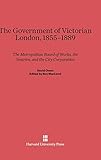The Government of Victorian London, 1855–1889 : The Metropolitan Board of Works, the Vestries, and the City Corporation / David Owen; ed. by Roy MacLeod.
Material type: TextPublisher: Cambridge, MA : Harvard University Press, [2013]Copyright date: ©1982Edition: Reprint 2014Description: 1 online resource (466 p.) : illustrationsContent type:
TextPublisher: Cambridge, MA : Harvard University Press, [2013]Copyright date: ©1982Edition: Reprint 2014Description: 1 online resource (466 p.) : illustrationsContent type: - 9780674863453
- 9780674863460
- 352.0421
- online - DeGruyter
| Item type | Current library | Call number | URL | Status | Notes | Barcode | |
|---|---|---|---|---|---|---|---|
 eBook
eBook
|
Biblioteca "Angelicum" Pont. Univ. S.Tommaso d'Aquino Nuvola online | online - DeGruyter (Browse shelf(Opens below)) | Online access | Not for loan (Accesso limitato) | Accesso per gli utenti autorizzati / Access for authorized users | (dgr)9780674863460 |
Frontmatter -- Contents -- Illustrations -- Editor's Preface -- Foreword -- The Government of Victorian London -- Introduction: Victorian London -- PART I: The Evolution of Metropolitan Government -- CHAPTER 1: The Crisis of London's Government -- CHAPTER 2: The Creation of the Metropolitan Board of Works -- CHAPTER 3: The Problem of Main Drainage -- CHAPTER 4: The Embankment -- CHAPTER 5: Thoroughfares and Buildings -- CHAPTER 6: The Miscellaneous Duties of a Municipal Government -- CHAPTER 7: The Routine of Administration -- CHAPTER 8: The Odor of Corruption -- CHAPTER 9: The Twilight of the Metropolitan Board of Works -- PART II: Vestrydom and the City Corporation -- CHAPTER 10: A Bird's-Eye View of Vestrydom -- CHAPTER 11: The City Corporation -- CHAPTER 12: St. Marylebone -- CHAPTER 13: St. Pancras -- CHAPTER 14: St. George the Martyr, Southwark -- CHAPTER 15: St. Leonard, Shoreditch -- Conclusion: Perspectives on Metropolitan Administrative History -- Notes -- Bibliography -- Index
restricted access online access with authorization star
http://purl.org/coar/access_right/c_16ec
Of all the major cities of Britain, London, the world metropolis, was the last to acquire a modern municipal government. Its antiquated administrative system led to repeated crises as the population doubled within a few decades and reached more than two million in the 1840s. Essential services such as sanitation, water supply, street paving and lighting, relief of the poor, and maintenance of the peace were managed by the vestries of ninety-odd parishes or precincts plus divers ad hoc authorities or commissions. In 1855, with the establishment of the Metropolitan Board of Works, the groundwork began to be laid for a rational municipal government. Owen tells in absorbing detail the story of the operations of the Metropolitan Board of Works, its political and other problems, and its limited but significant accomplishments--including the laying down of 83 miles of sewers and the building of the Thames Embankments--before it was replaced in 1889 by the London County Council. His account, based on extensive archival research, is balanced, judicious, lucid, often witty and always urbane.
Mode of access: Internet via World Wide Web.
In English.
Description based on online resource; title from PDF title page (publisher's Web site, viewed 24. Aug 2021)


